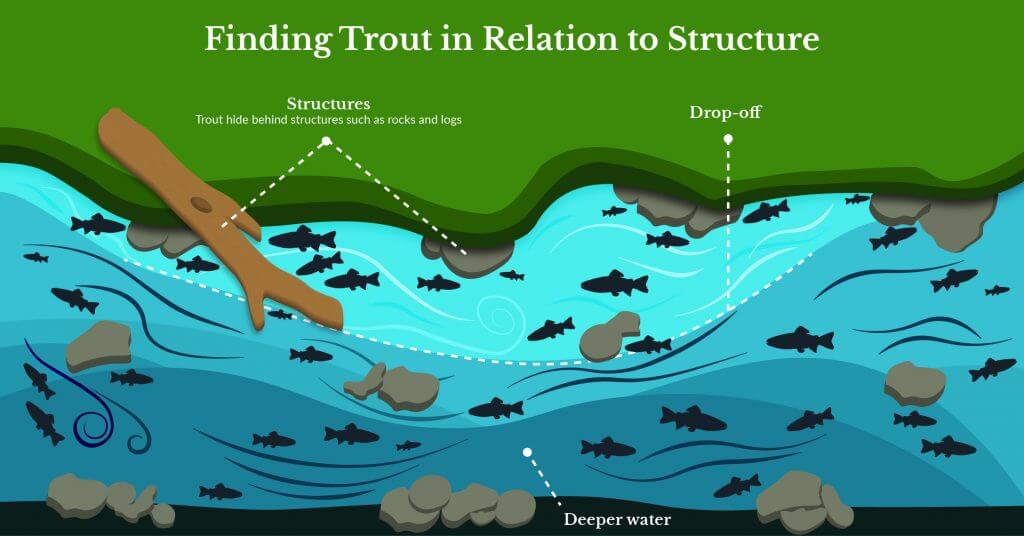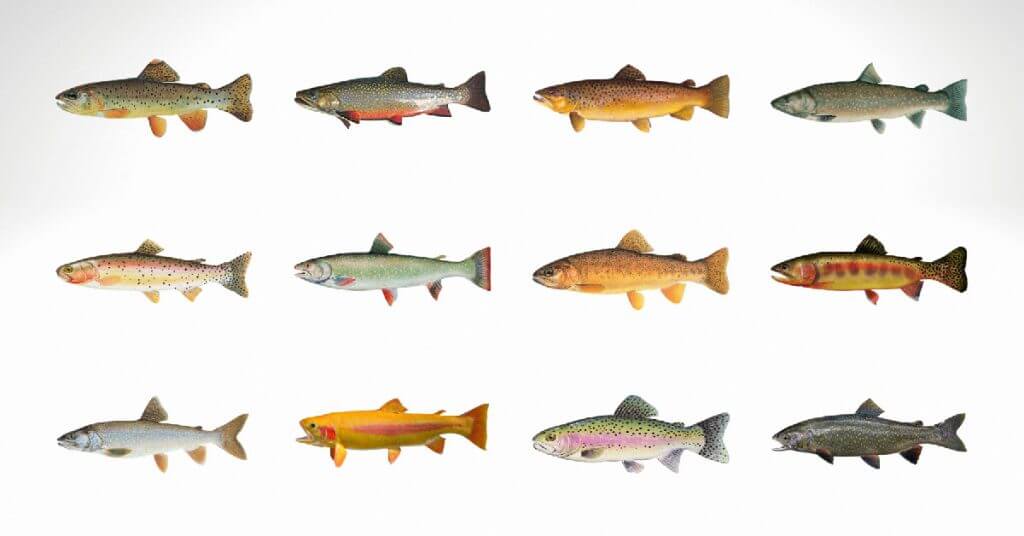Rainbow trout are perhaps the most popular trout species of all that we anglers love to fish for.
But with that being said, if you want to have a successful day on the water you need to keep many factors at the forefront of your mind so you don’t go home empty-handed.
These factors include (but not limited to):
- Location
- Water Temperature
- Food source
- Timing
Now, I know this can be overwhelming at first and that’s what I hope this article will help with.
I’m going to give my best advice after years of research and “on the water” experience so you too can learn how to catch rainbow trout in the most streamlined way possible.
Most recently, I fished the Beavers Bend State Park (video below) and these are the main takeaways I got from the trip:
- Look for deeper pools where cover is readily available
- Make sure your bait matches the trout’s food source (this changes based on stocked vs. wild)
- The morning is going to be your most productive time to go rainbow trout fishing.
- Where to Find Rainbow Trout
- The Best Time to Fish for Trout
- Rainbow Trout Baits
- Rainbow Trout Important Fishing Tips
- Frequently Asked Questions
- What is the best bait for rainbow trout?
- What is the best time to fish for rainbow trout?
- What depth do you fish for rainbow trout?
- What is the best setup for trout fishing?
- Is rainbow trout good eating?
- Do you need a sinker for trout fishing?
- Should you use a bobber when trout fishing?
- Does the sinker go above or below the hook?
- What size hooks for trout fishing?
- Should I use a swivel for trout fishing?
- Ending Remarks
Where to Find Rainbow Trout

The first thing you need to understand is where to find trout and the environment in which they thrive.
I can share my tips, tricks, and experiences with you all day long but that won’t do you any good if you’re casting in the wrong area.
Trout thrive in clean cold watersheds and like other game fish, they adapt to many different environments.
They can be found in high elevation mountain lakes and streams and also in southern low elevation rivers.
However, they are extremely sensitive to water conditions.
They need to have clean water and the water temperature needs to be above freezing and below 67 degrees Fahrenheit. Lastly, the water must support a food source for trout.
In several states, you can find a few trout species swimming in the same cold waters.
Rainbow trout, brown trout, cutthroat trout, and brook trout habitats often overlap.
This is because most trout species and subspecies require similar water temperatures to survive.
If the water conditions are optimal for one trout species they will likely be optimal for other trout species.
So where should you look whenever you go to your favorite fishing hole?
Well, that depends on two main factors. Are you fishing in moving water (rivers and streams) or still water such as lakes and ponds?
There are certain nuances that you need to understand for each body of water as your style will change for each situation.
How to Fish for Trout in Moving Water

Fishing for rainbow trout in moving water comes down to finding the deeper pools with cover.
While now and then you might catch one in the shallow riffles the majority of your fish will be caught in the deep slow-moving pools.
How can you find deep and slow-moving pools?
Deep slow-moving pools usually occur when a stream widens or shortly after (rapids) a quick drop in elevation.
Before and after riffles, dams, and log jams also cause the water to slow down and pool up.
To find cover, look for trees over the top, a rock, or a tree that has fallen into the water.
They will use cover to hide from predators as well as prey.
They will also use the rocks and trees as a current break to keep from using as much energy as they would fighting against the current.
99% of the trout I have caught in moving water have been in a deeper pool close to the cover of a rock or tree. If I catch one fish off of the cover I will quickly cast back to that same location and get another bite.

When using a spinning rod and reel, if you can see a rock or downed tree cast your bait as close to the cover as you can to entice a fish to bite. If the cover is not present cast your bait just past the edge of the riffles into the deeper pool where trout tend to hang out.
While fly fishing you will want to land your fly upstream and allow it to float down over the fish you are trying to catch.
How to Fish for Trout in Still Water
Fishing for trout in still water is a little different because more than likely the entire pond or lake is a relatively deep hole. So your only main option now is to find cover. This might be a rock pile, brush pile, or under a dock.
How do you find cover such as a rock or brush pile?
To be honest, this is going to be very difficult from the shoreline. You will have to physically see the cover or cast a time or two so you can feel it with your lure to know it’s there.
Pro tip: If you are in a boat equipped with electronics your life will be a lot easier trying to find cover and structures. Depth finders show them with sudden dips or points in the contour.
Rainbows will still need a place to hide from prey in still water. They won’t need to hide from predators as much since they can find deeper areas out of the reach of most predators in lakes and ponds.
I have noticed when fishing lakes and ponds the bites come in spurts. I will get a few bites and then nothing for a while. After waiting for a bit here comes another few bites. I believe this is because the trout are patrolling the waters in search of cover or food.
You can use fly fishing gear as well as ultralight tackle while fishing in non-moving waters.
When fly fishing you will have to land the fly near the trout or use the wind to push it towards the trout since there will not be a current. When using ultralight gear you will still want to cast into the cover.
The Best Time to Fish for Trout

You can fish all year round; any time of day BUT there are certain times when you will be more successful. I have found that 6:30 am to 8:30 am and 5 pm to sunset in the spring and fall are the best times to fish for trout.
Fish are most active during the early morning hours and late evening hours when the sun is not directly overhead. Planning your fishing trip during these times is best.
That doesn’t mean I haven’t caught trout in the heat of the midday summer sun. Nor does it mean trout won’t bite when the snow is falling.
Rainbow Trout Baits

Trout will eat anything they can get their mouth on. Minnows, nightcrawlers, salmon eggs, flying insects, terrestrial insects, and grubs are all on the menu.
They will even eat on other dead fish carcasses if other food is not available. Needless to say, they are not picky eaters.
The best trout baits are the ones that look most natural to the trout. If they are stocked then dough baits like Powerbait will work great.
If they are wild then a more natural-looking lure like a Kastmaster spoon will be my lure of choice.
I highly suggest checking your state’s wildlife department to find a list of waterways where they stock trout as switching up your bait depending on wild vs. stocked is vital to your success.
Personal Favorite: My favorite lure is a Super Duper spoon. Trout will hit it hard like a bass compared to other baits.
Flies are also awesome baits to use. Your choice of fly should switch depending on the time of year you are fishing. You will want to match the fly with the latest insect hatch in your local area. The best place to figure this out is at your local fly shop. If you don’t have a local fly shop, online charts can help get you in the ballpark.
Here is an online insect hatch chart for Eastern streams.
Here is an online insect hatch chart for Western streams.
In general, if your bait imitates any type of trout food you can catch rainbows on it. Sometimes it takes a little experimenting to figure out exactly what they are wanting that day so don’t be afraid to try several different baits if you know trout are in the area.
Rainbow Trout Important Fishing Tips
In the YouTube video above, Wes Littlefield gives away his best stocked rainbow trout fishing tips for beginners.
Now that you’ve figured out where to look, when to go, and what bait to use, let’s get into the nitty-gritty on how to catch more rainbow trout.
- When first learning, use a bobber to see the bite. Trout oftentimes bite lightly which is difficult to feel.
- Use a light line. Trout have excellent eyesight and live in clear water so they can see larger diameter fishing lines.
- While wading, move very slowly so you don’t spook any fish before being able to cast.
- A good pair of waders is a wise investment if you plan on wading for trout. Those waters are COLD!
- Don’t handle a trout too much if you plan on releasing it. They are delicate fish. Overhandling can cause serious damage and even death.
- Check your local fishing regulations before heading to your favorite fishing spot.
Frequently Asked Questions
What is the best bait for rainbow trout?
The bait that mimics their food source the best. Inline spinners or small spoons are my favorite.
What is the best time to fish for rainbow trout?
In the early morning or late evening of the spring or fall months.
What depth do you fish for rainbow trout?
Rainbow trout relate to the bottom. Often they patrol the waters about 1 1/2- 2 feet off of the bottom.
What is the best setup for trout fishing?
An ultralight rod and reel with a Super Duper spoon. I have caught the most trout using this setup.
Is rainbow trout good eating?
Yes. They are healthy and tasty fish.
Do you need a sinker for trout fishing?
Yes. You will often need a sinker to get your bait or lure closer to the bottom.
Should you use a bobber when trout fishing?
As a beginner yes. You should use a bobber until you can confidently tell when a trout bites your bait.
Does the sinker go above or below the hook?
Above. You will want the sinker above the hook so your bait will stay off the bottom.
What size hooks for trout fishing?
Size 8-12. Tiny hooks.
Should I use a swivel for trout fishing?
No. A swivel is unnecessary when trout fishing.
Ending Remarks
Rainbow trout fishing is still one of my favorite adventures to go on. I don’t know if it’s the beautiful scenery, the fight of the fish, or the crazy memories that always draw me back to the trout waters.
Most likely all play a big role in my desire to keep chasing trout and share my knowledge. Now that you understand the basics go have an awesome fishing adventure!



